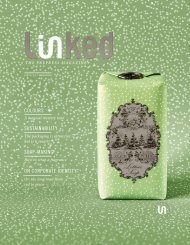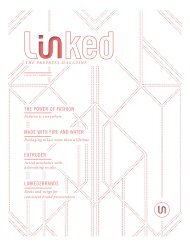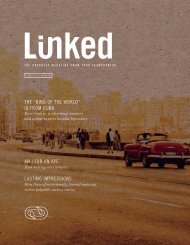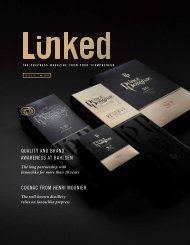Janoschka magazine Linked_V6_2021
Create successful ePaper yourself
Turn your PDF publications into a flip-book with our unique Google optimized e-Paper software.
20 i n s i g h t s
issue #6 ©
l i n k e d
21
Flat-bottomed bags
and folding cartons
While the Arbuckle brothers were conquering North America
with their packaged coffee beans, Margaret E. Knight invented
a machine that made flat-bottomed paper bags. These were
an initial step towards individual packaging: they allowed products
to be packaged and shipped on a large scale in small units
intended for private households.
In 1879, Robert Gair, a
Scottish-born American
inventor, followed with an
innovation that perhaps
marked the birth of modern, industrially produced
packaging: a machine-made folding carton. It soon
proved to be highly versatile and helped Gair establish
a business empire. Its advantages were many:
it provided ideal protection for packaged goods;
it could be stacked and easily transported; and all
six sides of the box could be printed with advertisements
– a key factor in its remarkable success.
We should remember that up until the mid-nineteenth
century, grocers sold “raw goods“. Tea, coffee
and other exotic and luxury goods came in simple
wooden chests, barrels, sacks and other containers.
Shopkeepers did sometimes sell “house blends“,
guaranteeing the quality of their products with their
name and giving customers detailed advice as a per-
sonal touch. Around this time, these goods started
to attract customers from further afield and therefore
needed to keep longer. Manufacturers began to print
their names – and the associated promise of quality –
on their packaging. The “market” was no longer ruled
by the traders. Manufacturers seized control, printing
advertisements on packaging, placing promotions in
magazines or posting advertising on large billboards –
all perfectly coordinated.
The demand for folding cartons sky-rocketed. They
were perfect for detergents, sugar and cocoa.
Colgate used them to package its soaps and toothpastes
and Ponds its beauty creams.
Robert Gair spent the rest of his life improving and
optimising “his” folding carton. At the same time,
he always focused on the lithographic process used
to print advertisements on the cartons. By 1927, the
year of his death, the world of packaging, consumption
and advertising had been revolutionised.
By pioneering and streamlining the large-scale manufacture and
lithography of inexpensive cardboard packaging, Gair provided
companies advertising space with which they could shape the public
image of their products.









